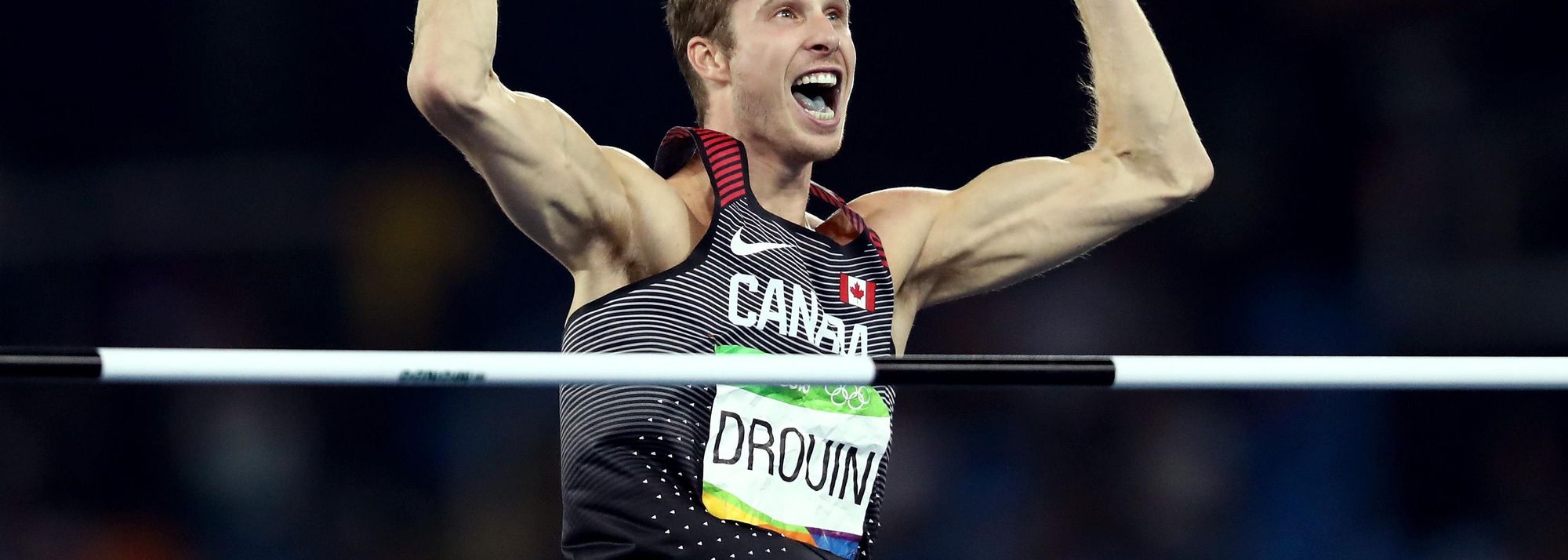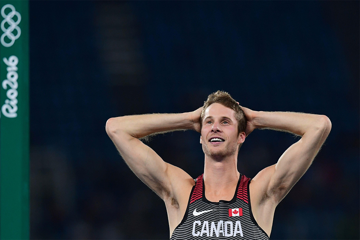Derek Drouin celebrates his Olympic high jump title in Rio de Janeiro (© Getty Images)
Nobody could have blamed Derek Drouin for greeting the news of the postponed Olympic Games with a fist pump, a high five and a cartwheel.
Virtually invisible from the sport since tearing his achilles tendon at the 2017 Diamond League meeting in Oslo, the Olympic high jump champion has been bedevilled by serious injury, which threatened to push the 1.94m tall Canadian into premature retirement.
Since his ill-fated appearance in the Norwegian capital, the 2015 world champion has been restricted to just three low-key competitions through a combination of two achilles tears and a serious spinal nerve injury which has threatened to permanently derail his career.
Yet despite the lows, he has refused to quit. Currently on the road back to full fitness, the news that the Tokyo Olympics has been pushed back a year following the Covid-19 pandemic buys the articulate Canadian the precious commodity of extra time.
“I had planned to come out and do some indoor meets (this year) but I felt the clock was ticking (to get an Olympic qualification mark),” says Drouin.
“I’m not going to lie, I was relieved for my own personal reasons that I had another year (to prepare for the Tokyo Games), although having said that I was also really hoping I would have the opportunity to jump this summer (and I’m not sure that is going to be the case).”
Drouin emerged as a world-class athlete in 2012 by winning a share of the bronze at the London Olympics. The following year he repeated the same podium spot at the World Championships in Moscow before embarking on a three-year unbeaten streak of major championship success by striking gold at the 2014 Commonwealth Games, 2015 Pan American Games and World Championships and 2016 Rio Olympics.
Post Rio, injury after injury
Yet post-Rio, the man who was raised in Corunna, Ontario, promptly lost his Midas touch as his career stalled through serious injury.
The pattern began after he tore his left achilles in Oslo 2017, an injury which ruled Drouin out of being able to defend his world title in London later that year.
“It was really tough, I was disappointed not to defend my title but I took the opportunity to heal and start training again in the fall,” he recalls.
Yet just two weeks after returning to training later that year, Drouin experienced an odd sensation when throwing a medicine ball in the air.
“As I moved my head back to watch the ball, my legs went tingly and numb," he says. “And I remember for the rest of the week my legs continued to feel a little numb.”
The problem was serious. Drouin had lost the feeling in his right side from his chest to his toes and the MRI scan revealed a badly herniated disc in his neck.
The decision was made for Drouin to take a prolonged break from jumping in 2018. Specialists recommended a vertebral fusion to fix the problem but Drouin was unconvinced this was the best solution.
An operation typically given to people aged 60 and above, he feared that even if he underwent the operation he may require follow-up surgery in the next 10 to 15 years. Contemplating the gloomy scenario, Drouin made a pact to himself.
“I didn’t want to undergo surgery," he explains. "I said to myself, 'I’m going to let this heal on its own. If this is the end of the road, and it doesn’t heal, then I’m retiring. If it does heal, then, hopefully, I’ll be cleared to high jump again'.”
Slow rehab begins
The rehab process was painfully slow and, at times, hugely dispiriting.
At his best, Drouin is a terrific all-round athlete with a decathlon best of 7150, but in 2018 he struggled to carry out basic balance exercises. Jumping from a plyometrics box was impossible and executing basic running mechanics would prove fiendishly difficult.
“I had a really tough time with any explosivity or reactivity – which is literally all the high jump is!”
With the disc pressing against his spinal cord, it took until the summer of 2018 for Drouin to starting running normally or jumping comfortably over a hurdle – a period of time when he discovered a potential solution to his ongoing neck issues.
He had met with a New York-based surgeon, who proposed revolutionary disc-replacement surgery in which the damaged herniated disc would be replaced by a titanium disc.
Surgery decision
More comfortable with the fact disc-replacement surgery would lead to a reduced likelihood of further surgery in the future, Drouin proceeded with the operation in August 2018.
On his return to training, he and his long-term coach, Jeff Huntoon, sensibly adopted a cautious approach.
“I had the surgery knowing the 2020 Tokyo Olympics was the goal,” says Drouin. “We took our time and knew the 2019 World Championships (in Doha) would be very late in the year.”
In April last year he tentatively returned to competition and off a five-step run up, cleared 2.13m and 2.14m, respectively in Riverside and Torrance, California.
He had aspirations to compete in Doha and says practice sessions off a shortened run-up were on par with his form in the countdown to the 2016 Olympics.
... then another injury
Yet, frustratingly, he still had issues with his right side which meant he could not feel pain. When poked by a needle or finger, he could not tell the difference. His team wisely adopted a conservative approach but despite this, in April 2019 he unknowingly tore his right achilles tendon.
“I remember back in 2017 the achilles tear I suffered led to excruciating pain, so to tear my right side and not have any indication that it was initially torn was tough to deal with.
“People say it would be awesome not to have to feel pain, but to feel pain is a good thing,” he says. “Being able to feel pain is a warning system for our body for a reason.”
After the rehab proved more extensive than initially planned, Drouin made the decision to end his competitive year, missing the 2019 World Championships in Doha, preferring to return to training to target Tokyo 2020.
Watching Barshim’s heroics from afar
The men’s high jump in Doha provided one of the highlights of the 10-day event in Qatar as Mutaz Barshim emerged from his own personal injury battle to strike gold in front of his adoring home fans.
Drouin himself opted to watch the final alone in his Toronto home but was elated for his good friend Barshim.
“I was curious how I would feel about watching the final, but I felt super pumped,” explains Drouin. “I sent him a message ten seconds after he won. He was the poster boy of Qatar athletics, and I can’t imagine the pressure he must have been feeling. He had only competed three times in the lead up to the World Championships but he must have had some indication as to the shape he was in. I know he is such a competitor, I thought he could win a medal. But I didn’t know if he had the victory in him. To win the gold, I could not have been happier for him.”
Drouin understands the challenge he faces to produce his own 'Barshim moment' in Tokyo following three years of struggle.
Now aged 30 - he will be 31 at the time of the rescheduled Tokyo Olympics - he still has to rediscover his explosiveness and power of old and find a way to harness this through his full nine-step run up.
If will not be easy. His body is far from symptom-free of the serious neck injury, but he remains cautiously hopeful.
“I don’t know if I would trust my body 100 per cent but I certainly feel I have definitely improved from a year ago,” he explains.
Currently in lockdown in Toronto, in recent weeks he has been forced to improvise part of his training programme. Unable to jump, he carries out weight sessions on his patio, plyometric work and circuits in the back garden and can carry out limited approach work.
It is far from ideal, but Drouin insists he can "roll with the punches” and, as an adaptable athlete, he is remaining relaxed.
He draws upon the belief he has previously climbed the highest peaks of the sport, and although success in Tokyo is a long shot, he is not about to give up. Not yet.
“With every major injury I’ve had in my career I’ve told myself, I don’t know at the end of all of this whether I’m going to be able to compete but I need to complete this rehab as if I’m going to,” he says. “I just have to substitute training like a professional athlete with rehabbing like a professional athlete. I still love this life I lead and I still love to compete.”
Steve Landells for World Athletics







